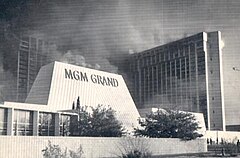
The Westgate Las Vegas Resort & Casino is a hotel, casino, and timeshare resort in Winchester, Nevada. Located near the northern end of the Las Vegas Strip, it is owned by Westgate Resorts. It opened in 1969 as the International Hotel, and was known for many years as the Las Vegas Hilton, then briefly as the LVH – Las Vegas Hotel and Casino. From 1981 to 1990, it was the largest hotel in the world.
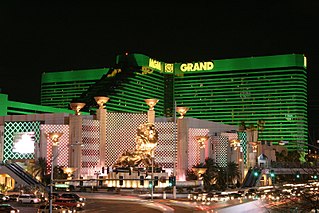
MGM Resorts International is an American global hospitality and entertainment company operating destination resorts in Las Vegas, Massachusetts, Michigan, Mississippi, Maryland, Ohio, and New Jersey, including Bellagio, Mandalay Bay, MGM Grand, and Park MGM.

The Las Vegas Strip is a stretch of Las Vegas Boulevard in Clark County, Nevada, that is known for its concentration of resort hotels and casinos. The Strip, as it is known, is about 4.2 mi (6.8 km) long, and is immediately south of the Las Vegas city limits in the unincorporated towns of Paradise and Winchester, but is often referred to simply as "Las Vegas".
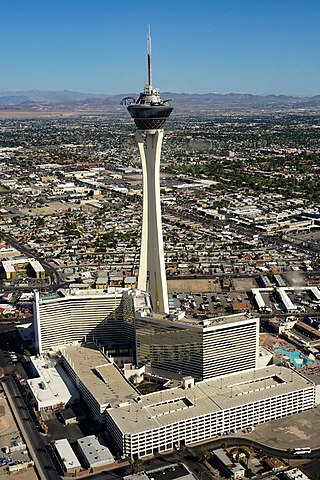
The Strat Hotel & Casino & Tower is a hotel and casino located in Las Vegas, Nevada, United States. It includes a 1,149 ft (350.2 m) observation tower, the tallest in the United States. It is also the second-tallest observation tower in the Western Hemisphere, surpassed only by the CN Tower in Toronto, Ontario. The tower is topped by a skypod which includes a revolving restaurant, lounges, and observation decks. The top of the tower also has several thrill rides. The hotel and casino facilities are situated at the base of the tower, and the resort also includes a showroom and a shopping mall. The Stratosphere is located within city limits on Las Vegas Boulevard, just north of the Las Vegas Strip. The resort is sometimes considered to be a Strip property, although Clark County does not officially recognize it as such, stating that the Strip does not extend into city limits.

Treasure Island Hotel and Casino is a pirate-themed hotel and casino located on the Las Vegas Strip in Paradise, Nevada, U.S. It includes 2,885 rooms and a 47,927 sq ft (4,452.6 m2) casino. The resort is owned and operated by businessman Phil Ruffin.
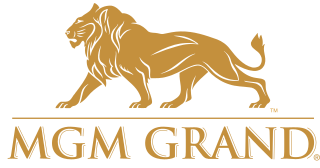
The MGM Grand Las Vegas is a hotel and casino located on the Las Vegas Strip in Paradise, Nevada. It is owned by Vici Properties and operated by MGM Resorts International. The resort was developed by Kirk Kerkorian through his company, MGM Grand, Inc. Kerkorian had previously developed another MGM Grand, opened on the Strip in 1973 and renamed Bally's in 1986.

The Boardwalk Hotel and Casino was a Coney Island-style hotel on the Las Vegas Strip. The property began in 1966, as a Holiday Inn. Norbert Jansen added a gift shop to the hotel in 1972, and later opened the Slot Joynt casino. In 1985, Jansen renamed the Holiday Inn as the Viscount Hotel, part of a U.S. chain. Four years later, he merged Slot Joynt with the Viscount and renamed them as the Boardwalk. It rejoined the Holiday Inn chain in 1994, through a franchise deal which eventually ended in 2002.

Park MGM, formerly Monte Carlo Resort and Casino, is a megaresort hotel and casino on the Las Vegas Strip in Paradise, Nevada, United States. It is owned by Vici Properties and operated by MGM Resorts International. It was developed by Mirage Resorts and Circus Circus Enterprises, both later acquired by MGM.

Circus Circus Las Vegas is a hotel and casino located on the northern Las Vegas Strip in Winchester, Nevada. It is owned and operated by Phil Ruffin. Circus Circus includes the largest permanent circus in the world. It features circus and trapeze acts, as well as carnival games, at its Carnival Midway. The resort also includes the Adventuredome, an indoor amusement park.
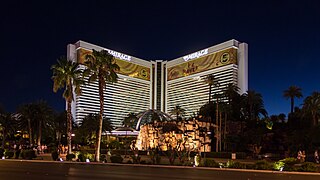
The Mirage is a casino resort on the Las Vegas Strip in Paradise, Nevada, United States. It is owned by Vici Properties and operated by Hard Rock International. The 65-acre property includes a 90,548 sq ft (8,412.2 m2) casino and 3,044 rooms.

The DunesHotel & Country Club was a hotel and casino on the Las Vegas Strip in Paradise, Nevada. It opened on May 23, 1955, as the tenth resort on the Strip. It was initially owned by a group of businessmen from out of state, but failed to prosper under their management. It also opened at a time of decreased tourism, while the Strip was simultaneously becoming overbuilt with hotel rooms. A few months after the opening, management was taken over by the operators of the Sands resort, also on the Strip. This group failed to improve business and relinquished control less than six months later.

Horseshoe Las Vegas is a casino hotel on the Las Vegas Strip in Paradise, Nevada. It is owned and operated by Caesars Entertainment. It originally opened as the MGM Grand Hotel and Casino on December 4, 1973. The 26-story hotel contained 2,100 rooms and was among the world's largest hotels.

Circus Circus Reno is a hotel and casino located in Downtown Reno, Nevada. It anchors a network of connected hotel-casinos in the downtown Reno core that includes Silver Legacy Reno and Eldorado Reno and are owned and operated by Caesars Entertainment. It includes a 1,620 room hotel and a 66,515 sq ft (6,179.4 m2) casino which features free circus acts on a regular basis throughout the day over the midway which also offers 33 carnival games.

Sahara Las Vegas is a hotel and casino located on the Las Vegas Strip in Winchester, Nevada. It is owned and operated by the Meruelo Group. The hotel has 1,616 rooms, and the casino contains 50,662 square feet (4,706.7 m2). The Sahara anchors the northern end of the Las Vegas Strip, at the corner of Sahara Avenue. It is the site of the northernmost station of the Las Vegas Monorail.

Grand Sierra Resort is a hotel and casino located approximately three miles east of Downtown Reno, Nevada. The hotel has 1,990 guest rooms and suites, 27 floors, 12 restaurants, including Charlie Palmer Steak by celebrity chef Charlie Palmer, and a casino with 80,000 sq ft of space. GSR has a movie theater, a Race & Sports Book, nightclubs including LEX Nightclub, a 25,000 sq ft venue with a swimming pool, lake golf driving range, a two screen cinema, an RV park and a recently opened ice rink. It is owned and operated by Southern California based investment group headed by The Meruelo Group.
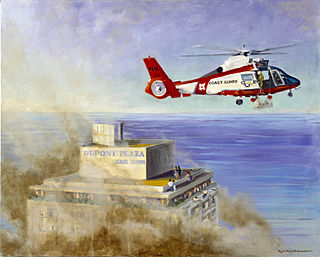
On New Year's Eve, December 31, 1986, three disgruntled employees at the Dupont Plaza Hotel in San Juan, Puerto Rico, intentionally set a fire. The employees were involved in a labor dispute with the owners. The fire killed between 96 and 98 people and injured 140 others. It is the most catastrophic hotel fire in Puerto Rican history and the second deadliest hotel fire in U.S. territory in history, after the Winecoff Hotel fire in Atlanta in 1946.

The Cromwell Las Vegas is a luxury boutique casino hotel on the Las Vegas Strip in Paradise, Nevada. It is owned and operated by Caesars Entertainment. It was originally opened by Michael Gaughan as the Barbary Coast on March 2, 1979. Several nearby resorts were opposed to its construction, partially due to concerns about increased traffic congestion. The property featured Victorian décor and later became part of Gaughan's company, Coast Casinos. The Barbary Coast would go on to add two popular restaurants, and a nightclub by Victor Drai.

Las Vegas Club was a hotel and casino located on the Fremont Street Experience in downtown Las Vegas, Nevada. The Las Vegas Club opened in 1930, joining the Las Vegas Hotel which had opened in 1908. The Las Vegas Club was relocated across the street in 1949. At its new location, the Las Vegas Club operated within the Overland Hotel, which was established in 1905.
The El Rancho Hotel and Casino was a hotel and casino that operated on the Las Vegas Strip in Winchester, Nevada. It originally opened on September 2, 1948, as the Navajo-themed Thunderbird. At the time, it was owned by building developer Marion Hicks and Lieutenant Governor of Nevada Clifford A. Jones. A sister property, the Algiers Hotel, was opened south of the Thuderbird in 1953. During the mid-1950s, the state carried out an investigation to determine whether underworld Mafia figures held hidden interests in the resort. Hicks and Jones ultimately prevailed and kept their gaming licenses. Hicks died in 1961, and his position as managing director was taken over by Joe Wells, another partner in the resort. Wells added a horse racing track known as Thunderbird Downs, located behind the resort. The Thunderbird also hosted numerous entertainers and shows, including Flower Drum Song and South Pacific.
The following is a timeline of the history of the city of Las Vegas, Nevada, United States.
